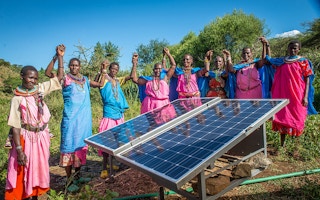Until almost two years ago, James Mbugua, a farmer living in Karai, a village on the outskirts of Kenya’s capital, relied on kerosene to light his house, and a car battery to power his television so he wouldn’t miss the news.
Part of the reason he couldn’t plug into the power grid, despite being so close to Nairobi and in an area where electricity is readily available, is that he lives on government land as a squatter, with no papers to show he owns the 70-foot by 80-foot parcel where he has put up a makeshift house.
Now, however, he has found an alternative: An affordable solar system to power his home.
“I could not go on like that and had to seek an alternative way of lighting my house and I discovered that with only $150 I could use solar to light my house and power the television plus radio,” he told the Thomson Reuters Foundation.
The money for the purchase, he said, came from a loan from his community savings group, which asks members to contribute $5 a month and then offers loans from that pot of cash.
The father of five grown children is one of the millions of people across Africa who are taking advantage of falling prices of home solar panel systems to get cheaper, cleaner and more reliable energy.
“
About 60 million people may be using off-grid renewable electricity of some kind in Africa. That is about 10 per cent of those living off-grid.
Adnan Z. Amin, director-general, International Renewable Energy Agency
According to the International Renewable Energy Agency (IRENA), home solar systems in Africa can now provide electricity for many households for as little as $56 a year - a cost lower than getting energy from diesel or kerosene.
Of the estimated 600 million people living off-grid in Africa, about 10 per cent of them are now using off-grid clean energy to light their homes, according to IRENA statistics.
“About 60 million people may be using off-grid renewable electricity of some kind in Africa. That is about 10 per cent of those living off-grid,” IRENA Director-General Adnan Z. Amin said at a recent off-grid renewable energy conference in Nairobi.
Solar, phones and cash
In East Africa alone, more than 350,000 people are now using solar panels to light their homes and technologies such as mobile phone-based money transfers to pay for the technology, he said. That suggests renewable energy could be a major driver to help the region meet a new U.N. Sustainable Development Goal to provide universal access to electricity by 2030.
“Here in Kenya, we find ourselves at one of the global epicenters of growth, where solar products combined with pay-as-you-go models and mobile payment technologies are breaking new ground in bottom-up electricity sector development,” Amin said.
According to Joseph Njoroge, Kenya’s energy and petroleum principal secretary, solar mini-grids - small-scale electricity networks, sometimes combined with wind power as well - are expected to play a major role in bringing electricity to sparsely populated but vast northern Kenya, as well as to other areas not connected to the national grid.
“We have a third of Kenya’s population living in the northern part of the country, which is also two-thirds of the total area of the country, and it is here that we shall hugely deploy solar mini-grids to attain universal access to power - possibly even before the year 2030”, Njoroge said.
Last August Kenya won $36 million in support from France to put in place 23 mini-grid systems in northern Kenya that will use solar panels, wind or a combination of the two.
60 per cent price drop?
IRENA predicts that ongoing renewable energy innovation, including new business models and finance, will result in a 60 per cent decrease in the cost of producing electricity from renewable mini-grids in the next 20 years.
Such significant cost drops are being seen not just in Africa but across the world, IRENA officials said. They attribute the cost declines to technological innovations, changes in regulatory policies and an improved investment environment for private money.
Solar home lighting systems - which now cost about $120 for a small-scale system in Kenya - have fallen by as much as 80 per cent since 2010, according to IRENA. The agency noted that it expects the trend to continue.
At the same time, investments in off-grid solar systems globally grew by 15 times between 2012 and 2015, with $276 million spent on them in 2015.
Employment in the renewable energy sector worldwide hit 8.1 million jobs in 2015, an increase of 1.3 million compared to 2014, IRENA said. Solar panels led the way with 2.7 million jobs created.
In addition to lighting homes for the poor, off-grid renewable energy is being used to power things like health and education facilities, agriculture and water access - helping achieve at least a dozen of the other new Sustainable Development Goals, an IRENA report said.
This story was published with permission from Thomson Reuters Foundation, the charitable arm of Thomson Reuters, that covers humanitarian news, climate change, women’s rights, trafficking and property rights. Visit http://news.trust.org/climate.










